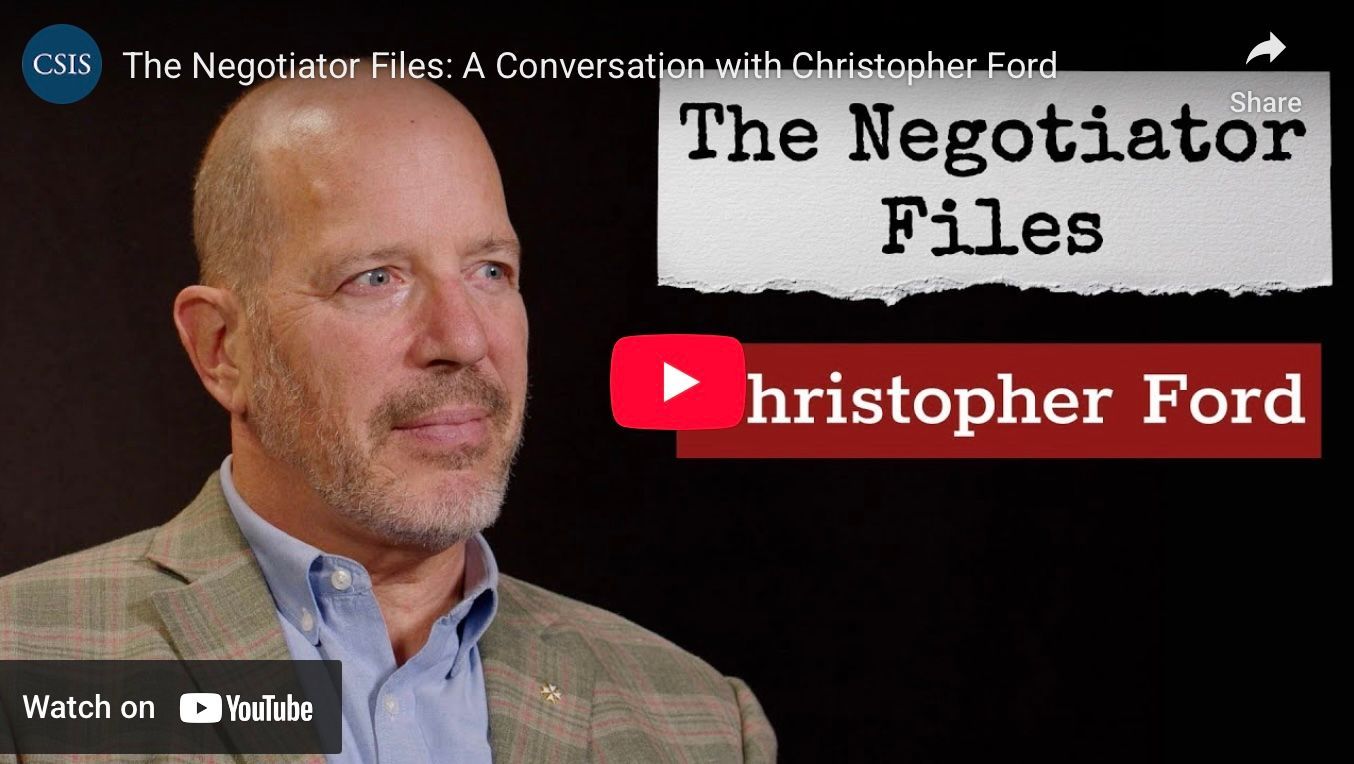Arms Control and Disarmament Through the Prism of Complexity: Advent of a New Research Agenda?
Dr. Christopher Ford • October 1, 2021
Below follow remarks Dr. Ford prepared for a Nuclear Security Dialogue group sponsored by the Hoover Institution and the American Association for the Advancement of Science on October 1, 2021. (They can also be found on Medium, by clicking here.)
I. Engineering for Yesterday versus Tomorrow
It is perhaps one of the characteristics of the modern era that at major juncture points in history, particularly in the wake of some major conflict, crisis, or shift in the international system, leaders try to establish new organizations and institutions to prevent the recurrence of problems highlighted by the period through which they had just passed. These projects do not always succeed, of course — or to the degree that they do work for a time, their participants tend eventually to run afoul of other
dynamics largely unaccounted for in the design — but the last two centuries have indeed seen a striking pattern of iterated institution-building focused upon preventing the last crisis.
While it has thus become “normal” to try to look back at problems through which one has just come and try to devise ways of preventing their recurrence, therefore, what is more rare is a systematic effort to look forward
at what sorts of organizations, institutions, and mechanisms one might need in the face of future
challenges. In particular, when it comes to the challenges of nuclear disarmament, there has been relatively little effort so far to think through new, more-future-oriented ideas.
One effort that has
been undertaken is the International Partnership for Nuclear Disarmament Verification, albeit only looking at a very small slice of a very big challenge. Another — and more ambitious — effort is the “Joint Enterprise” with which Jim and Steve Pifer
have been so compellingly connected, aiming to create “a global coalition of nations taking specific national initiatives to move the world back from the nuclear precipice by means of a work plan of “commitments to near-term actions.”
During the previous administration — for reasons I’ll outline in a moment — we took a somewhat different approach, however, shifting away from such efforts to plan our way to a very specific, nuclear weapons-free future through adherence to particular, disarmament-focused policy agenda items and towards the open-ended diplomatic engagement of the Creating an Environment for Nuclear Disarmament
initiative, or CEND. Its objective was to try to develop a new and more security-focused approach to disarmament dialogue, but it deliberately avoided outcome-specificity, urging instead a focus upon understanding — and, if possible, working to adjust — the incentives that underlie nuclear weapons possession and the mechanisms that reinforce or reward nuclear-eschewing policies and security choices, and the reduction of nuclear risks until such point as nuclear weapons may eventually be eliminated.
The ethos behind CEND, therefore, is a very different one than one sees underlying traditional approaches to disarmament — which tend to offer specific policy recipes that, it is said, will if adopted ensue a safely and securely disarmed security environment. Why this peculiarity in CEND’s approach? Why this focus upon participant incentives and open-ended, pathway-independent exploration of issues and possibilities? And why the avoidance of traditional “here’s how you need to solve the problem” discourse? Some of why
we did this lies in my effort to think about these problems through the prism of Complexity Science.
II. Disarmament and Complexity
So let me explain. Arms control and disarmament negotiation has traditionally tended to assume that it is possible, in effect, to “solve” the strategic “equation” between its parties in a way that amounts to the functional equivalent of finding a Nash Equilibrium. It presumes, in other words, that there is some arrangement that provides a “best available” payoff for both parties, and from which neither should have incentive to deviate, because such a departure would result in both being more disadvantaged.
This conception assumes that the parties are operating on a fixed landscape of potential solution sets, so that the objective is to identify — and to fix in place through legally-binding treaty mechanisms — a position on what is at least a local peak, away from which any movement would represent a loss of utility. But this model fails to account for the fact that the security environment is a complex adaptive system, a sort of configuration that is in many ways powerfully resistant to Nash-style “solutions” of this sort, or indeed to an enduring solution of any
kind.
A system can become “Complex” when it is made up of elements that are diverse, interconnected, and adaptive — that is, when not all units are of the same type, the actions of any one unit affect other units, and these units actively change their behavior in response to the choices made by other actors. This would certainly seem to be the case in the global security environment that the disarmament community seeks to reengineer into a nuclear-free, lower-volatility, more stable and sustainable form.
Yet it is a characteristic of complex systems that they tend to produce not static
(and hence theoretically solvable) landscapes of this sort, but rather dynamic
ones that frequently change due to ongoing adaptative choices by the diverse and interconnected actors that make up the system. Such systems tend to create the kind of environment that I’ve heard referred to as a “dancing landscape.”
This suggests a real challenge for traditional policymaking. Specifically, it raises the possibility that traditional approaches are ill-suited to such dancing landscapes to the degree that they seek to confine their parties to “exploiting” the utility payoffs of a single point on the systemic terrain — specifically, that point at which the parties have arrived by negotiation, and which is thereupon fixed in place through a treaty — rather than “exploring” other possible positions. They seek, in other words, static rather than dynamic answers.
If this mismatch is indeed a problem created by Complexity, it is worsening. In the Cold War-era arms control to which we have become accustomed, negotiations were principally dyadic, involving only two parties at a time when their stockpiles were such that the arsenals of all the other nuclear possessors — put together — amounted to little more than a rounding error. Those talks, moreover, focused primarily upon regulating the currency of a single axis of rivalry — strategic weapons — at a time when both sides either perceived diminishing returns in their expanded possession (during the era of détente) or already felt that strategic circumstances had changed in a way that made it necessary to retain far fewer of them (after the end of the Cold War). By contrast, the disarmament problem today involves trying to solve an equation that involves at least eight present-day possessors, dozens of “nuclear umbrella” alliance partners, and an uncertain but presumably large number of additional players whose security interests could be affected dramatically by any answers arrived at among the great powers and other possessor states.
Furthermore, the relevant parties now are not just more numerous
than in the era of bilateral arms control, but also much more diverse, finding themselves in a range of politico-military circumstances far more varied than those that existed simply between the two nuclear superpowers during the Cold War. They are also arguably much more interconnected.
It is not merely, for instance, that China’s current sprint to hugely expand the size of its strategic arsenal is likely to have serious implications for what it is possible to imagine being negotiable between the United States and Russia. It is also that what China is doing is likely to have an impact upon India’s
perceived strategic interests and nuclear deterrence needs, which in turn could have a profound affect upon Pakistani
calculations. As observers have warned for years about nuclear proliferation, as the number of players increases arithmetically, the number of relevant axes of interaction will expand geometrically, and one can already see this underway.
Nor is the problem just one of nuclear weaponry itself. Negotiators in the 1970s thought they had found a bilateral solution set in coupling limits on strategic weapons with limits on defensive systems. Over the last generation, however, we’ve seen how U.S. missile defense decisions made purely in response to third-party North Korean and Iranian missile threats can produce “ripple effects” in Russian and Chinese strategic planning.
Such cross-domain ripple effects seem likely to proliferate, with feedback loops likely to be especially challenging given that the contemporary nuclear weapons arena is already significantly entangled with fast-changing emerging technology arenas that have potential strategic impact, such as cyberspace and outer space. The “thickness” of the web of strategically-relevant relationships and interactions will surely be great indeed in a world of emergent technologies and increasingly “cross-domain” effects.
And, of course, to the degree that nuclear weapons are
eventually reduced in number and then eliminated, even traditional conventional
military imbalances — and perhaps underlying asymmetries in economic power, demographic weight, and technological sophistication — would become far more strategically salient. Furthermore, since the knowledge of how to make
nuclear weaponry would presumably have not been entirely erased, some answer would also have to be found that managed the interplay of such imbalances with any persisting global or regional rivalries or antipathies enough to avoid creating incentives for nuclear reconstitution.
Nothing here, in other words, suggests a Nash-like “equation” that can be enduringly “solved” in the way we have traditionally approached arms control and disarmament negotiation.
III. Perhaps Not Hopeless, But Likely Very Different
I make this point not because I think such Complexity necessarily demonstrates that nuclear disarmament is theoretically impossible. It may well mean, however, that we have been approaching the problem in the wrong way, by assuming that it is susceptible to a type
of solution that in fact it is not.
Various thinkers have tried to apply Complexity insights to improve decision-making and organizational design within corporate or governmental governance structures. There has so far been little work, however, on Complexity’s implications for the highest forms of national policy and strategy such as arms control and disarmament policy.
Policymakers tend traditionally to assume a linearity in the policy process, in which purposive inputs will (or at least can) lead predictably to desired outcomes. Arms control and disarmament negotiators also generally assumed that it is at least theoretically possible to negotiate their way to stable and enduring “solutions” to the strategic “equation.” Yet Complexity Science seems to call these assumptions into doubt.
Complexity scientist David Krakauer, for instance, has noted the striking degree to which so many efforts to employ policy interventions to resolve pressing challenges in human society “have foundered and failed through the misapplication of previously highly successful ideas of engineering and design to complex systems” because complex
systems do not respond well approaches that presume that clear paths to desired outcomes can be analyzed, predicted, and followed. Similarly, according to David Colander and Roland Kupers, “[t]he central narrative of complexity science” shows a complex adaptive social system to be “beyond the control of government or anyone” and strikingly resistant to purposive social engineering.
For an arms control and disarmament enterprise that seeks, in effect, to engineer stable and peaceful outcomes in the global security environment through a pre-established, step-by-step agenda of specific treaty enactments and policy choices
these insights are probably pretty disastrous. Nevertheless, perhaps there is more we can do in learning from applied
Complexity something about how to approach future challenges more successfully.
In their book Harnessing Complexity, for instance, Robert Axelrod and Michael Cohen admit that “[t]he complexity of the world is real” and that “[w]e do not know how to make it disappear.” But they also think it yet possible to devise
“a framework, a way of thinking through a complex setting that takes advantage of complexity to generate new questions and new possibilities for action. It suggests ways of ‘harnessing complexity’ … a device for channeling the complexity of a social system into desirable change ….”
One effort to think through such challenges was made by David Snowden and Mary Boone in the Harvard Business Review
in 2007. They suggested a framework for thinking about policy interventions in the complex adaptive systems environment of business organization and management. They described four basic types of possible decision-making environment: “simple,” “complicated,” “complex,” and “chaotic.” Each has its own peculiar dynamics, and each calls for somewhat different types of response from leaders tasked with making decisions therein.
So perhaps we can approach our
questions through this prism as well. But here’s the rub: if the global security environment is a complex adaptive system, this framework — and indeed Complexity thinking more generally — would seem to suggest that the arms control and disarmament community has been going about things quite wrong in presuming that this environment will respond well to traditional, linear-type policy interventions that are predicated upon this being a “simple” or “complicated” scenario.
But what would a Complexity-informed agenda in this area actually look like? A key point is to remember that in Complexity, system behavior is not
the result of specific policy choices by any given actor — including yourself — but is in a sense a higher-level pattern that emerges out of the interaction of its elements. This suggests that in a genuinely Complex environment, policy interventions may need to be aimed not at driving the system directly from an unsatisfactory present “Point A” to a more desirable future “Point B,” as traditional policymaking attempts. Instead, it’s about attempting to adjust the interactive characteristics of the system itself
in an effort to “tune” it probabilistically, such as to reduce (if perhaps not eliminate) the likelihood of extreme events out on the “tail” of a power-law curve.
In principle, I would think, it ought to be possible to characterize the security environment, or major relevant aspects of it, in Complexity-informed terms, such as through careful looks at the characteristics that give rise to complexity — such as the number and diversity of stakeholders, the nature and intensity of their interconnectedness, and the ways and rate at which they change their strategies to adapt to changes in the environment caused by others’ changes in strategy — and perhaps to manipulate such dynamics in constructive ways. Axelrod and Cohen, for instance, refer to the various tangible or intangible factors that affect how likely agents are to interact within a system as those agents’ “proximity,” and they suggest that the manipulation of tangible or figurative “barriers” between agents or classes of agents — gates, if you will, modulating how and when they engage with each other — might be one tool with which to help manage complex dynamics by adjusting the frequency, nature, and intensity of agent interactions within the system.
Applying this to arms control and disarmament, one could perhaps understand nonproliferation as a way of controlling the number and diversity of relevant agents interacting in specifically nuclear
ways. Complexity insights would seem to vindicate the long-held assumption that more nuclear weapons “players” equates to more risk of systemic breakdown in the form of nuclear conflict. If it is the degree of complexity that presents us with the “policymaker’s paradox” that undermines traditional linear policymaking and raises the chances of catastrophic extreme outcomes along the “tail” of the system’s power-law curve through runaway feedback loops, therefore, it may be more important than ever to succeed in the very traditional agenda of preventing the further proliferation of nuclear weapons and indeed also the mere capacity
to produce them.
Furthermore, to the degree that existing arsenals can be capped and then reduced without exacerbating the risk of conflict between actual or potential possessors, this would also help at least limit the scope of the problem — not to mention reducing the damage should deterrence fail. And, of course, even small
steps to reduce tensions and escalatory potential in the world’s conventional or potential nuclear hot spots would presumably also help reduce the risk of catastrophic outcomes.
Another potential approach is suggested by well-known tradeoff dynamics faced by agents in a complex adaptive system between “exploiting” the payoffs of a single point on the systemic terrain and “exploring” other possible positions. In theory, there would not seem to be an a priori
answer to this challenge, for the “right” balance between these activities will depend upon where one is on the figurative landscape relative to other possible utility peaks and how long that situation is likely to continue — both things that it can be all but impossible to know in a complex adaptive system.
Axelrod and Cohen, however, suggest several sorts of questions to try ask about one’s systemic terrain in order to glean insight into how valuable “exploration” versus “exploitation” is likely to be under the circumstances. They suggest, for instance, that “exploration” is likely to be relatively more valuable to the degree that the problem with which one is concerned is long-term or widespread, when fast and reliable feedback can be had about the effects created by a policy intervention, when the downside risk of exploration activity leading to some catastrophe is relatively low, or when there are clear risks of “looming disaster” from not
exploring. For their part, Snowden and Boone advocate looking for opportunities to assess the likely systemic impact of an intervention by conducting exploratory “experiments that are safe to fail,” in which one is able to “probe first, then sense, and then respond.”
What might these suggestions mean in the arms control and disarmament arena, in which traditional approaches have tended to try to “solve” a security equation and then fix the result in place over the long term in treaty form? Should more be done to facilitate periodically “revisiting” the policy conclusions encoded into our arms control and disarmament institutions, on the assumption that yesterday’s attempt at a Nash-type solution may not necessarily represent the best “fit” for tomorrow’s world? If indeed we are stuck living on “dancing” landscapes, should we somehow make more provision in our design logics for responsive reexamination?
Making such exploratory “reexamination” opportunities pay off, moreover, may require a new and different approach to diplomatic engagement, at least in the lead-up to negotiations, and perhaps even in them. With CEND, for instance, we tried to pioneer a form of “exploration”-focused disarmament dialogue, in which participants — even though they were actually real diplomats representing real countries — are encouraged to engage in open-ended, candid, and quite unstructured, “Track 2”-style discussions on a not-for-attribution basis. In the future, perhaps more can be done to catalyze “exploration” behavior across the board, with analogous practices being employed to enhance engagement in other contexts and in other institutions.
Perhaps most fundamentally, we should remember Krakauer’s suggestion that in Complexity, one must “[a]ccept significant component error rates and focus on mechanisms that can average and aggregate these effects to acceptable levels in the collective output,” while designing “with an eye towards distributions of outcomes and not towards deltas (single optimal outcomes), pursuing average properties throughout.”
“Perhaps the greatest ‘phase transition’ in our thinking that such an approach could engender is the maturation in our willingness to live with relatively high levels of uncertainty in the domains of complex phenomena — and thus give up on ideas like complete ‘cures,’ the elimination of ‘risk,’ the design of perfect ‘stability,’ and achieving total ‘security.’ We replace these ideals of a deterministic age with an understanding of the ever-evolving nature of adaptive processes, seeking to discover new methods for the specification of incentives, rewards, constraints, and communication, together capable of moving outcomes into a space of desirable, albeit never optimal, performance.”
The disarmament community may not like to hear this, but we may need to remain alive at least to the possibility
that in light of the understandings suggested by Complexity Science, a rigid fixation upon “Zero” isn’t necessarily the right type
of answer to our disarmament challenge in the first place. Recall, for instance, that while an extraordinarily efficient “just in time” delivery system may provide optimum value for money in a supply chain under optimum conditions, such finely-tuned systems often fail badly in the face even of small perturbations. Understanding this, wise managers often deliberately build some “slack” or redundancy into their system. Such measures somewhat reduce efficiency, but the resulting architectures often tend to “fail more safely” than fine-tuned arrangements; this can provide an invaluable insulation against catastrophe in the face of the unexpected.
By analogy, given the number of things that would have to go right in the complex system of the global security environment — and, in a sense, that would also have to stay
right — in order for complete nuclear disarmament to work, it may be worth thinking about our objective not in absolute and static terms but in relative
and dynamic
ones. If the point is to reduce nuclear risks and further international peace and security, and if indeed our complex global landscape “dances” in ways that are inherently difficult or impossible to predict, focusing upon too rigid a solution set might actually be counterproductive: a configuration “self-organized to criticality” in ways that make it vulnerable to systemic breakdown and reconfiguration.
Attempting to apply insights from Complexity Science, scholars such as Scott Sagan
have argued that some aspects of the nuclear superpowers’ Cold War-style nuclear postures — which he characterizes as having high interactive complexity and “tight” organizational “coupling” in their command-and-control architectures — were or are, in effect, dangerously self-organized to criticality. It might equally be asked, however, whether the envisioned global end-state of complete nuclear disarmament could be said to suffer from loosely analogous defects in its assumption that in a fast-changing and deeply interconnected world of asymmetrically-situated, often fractious, frequently rivalrous, and always fallible technology possessors, large-scale aggression and nuclear reconstitution can be precluded through consensus agreement upon the Nash equilibrium of some clever institutional design.
It is for this reason that Complexity suggests the possibility that there is some alternative vision of the world — one perhaps quite different and hopefully less dangerous that of today, but nonetheless still notably far removed from the absolutist and utopian “Zero” of fond disarmament community imaginings — which could represent a better
answer to the dynamic challenges of the security environment. I speculated years ago, for instance, that
“[i]f a disarmed world cannot be made reasonably secure against large-scale conventional conflict and against ‘breakout’ by countries seeking nuclear weapons … such a nuclear weapons-free world should not necessarily be preferred to today’s world — in which there has not been a full-blown Great Power war for many decades, and in which proliferation still faces at least some constraints. And an insecure world free of nuclear weapons should surely not be preferred to a future world in which such weapons continue to exist, but in which possessors have only quite small arsenals and have reduced the salience of nuclear weapons in their defense planning, in which limited missile defenses and early-warning data-sharing help reduce the risk from proliferation and from false alarms, in which nonproliferation obligations have become universal, proliferation-facilitating technologies are carefully controlled, and violations are deterred by a high probability of swift negative consequences, and in which all major weapons-possessors benefit from some kind of general transparency and confidence-building treaty regime.”
Perhaps it is possible to imagine at least an interim
world — on the way to who knows what? — that is both less dangerous than our own world today and
more stably and resiliently peaceful over time than one in which all existing nuclear weapons had simply been prohibited and dismantled pursuant to the sort of prohibitory treaty mechanism desired by the conventional wisdom of the present-day disarmament community. Either way, I would argue that we need more Complexity-informed, exploratory thinking about global design solutions.
Whether or not these tentative and preliminary thoughts make sense, or what more significant insights Complexity can offer if one delves into such matters more thoroughly, it is surely far too early to say. But I do think that evolving modern understandings of Complexity Science underline the importance of interrogating the disarmament community’s traditional assumptions and reframing its narratives and agenda.
These understandings, moreover, hold out the possibility of learning important things in other areas as well. In fact, I see a new research agenda developing across the terrain of national and international policymaking wherever it has hitherto been our traditional instinct to apply assumptions of linearity and outcome-predictability to genuinely Complex problems — which is to say, very broadly indeed.
-- Christopher Ford
Dr. Ford's essay on the history of Missouri State University's School of Defense and Strategic Studies was published in Defense & Strategic Studies Online (DASSO), vol. 2, no. 1 (Autumn 2025). You can find the whole issue on the DASSO website here , or use the button below to download a PDF of Dr. Ford's piece . (Also, the home page for DASSO can be found here .)

On September 17, 2025, the website Fair Observer published Dr. Ford's essay looking back on the terrorist attacks of September 11, 2001, and musing about the challenges facing America's political culture today. You can find the essay on Fair Observer 's webpage here , or use the button below to download a PDF.
Dr. Ford's article on "Thinking About Strategy in an Artificial Superintelligence Arms Race" -- co-authored with Dr. Craig Wiener -- was published in Defense & Strategic Studies Online (DASSO), vol. 1, no. 4 (Summer 2025). You can find the whole issue on the DASSO website here , or use the button below to download a PDF of the Ford/Wiener article. (Also, the home page for DASSO can be found here .)






